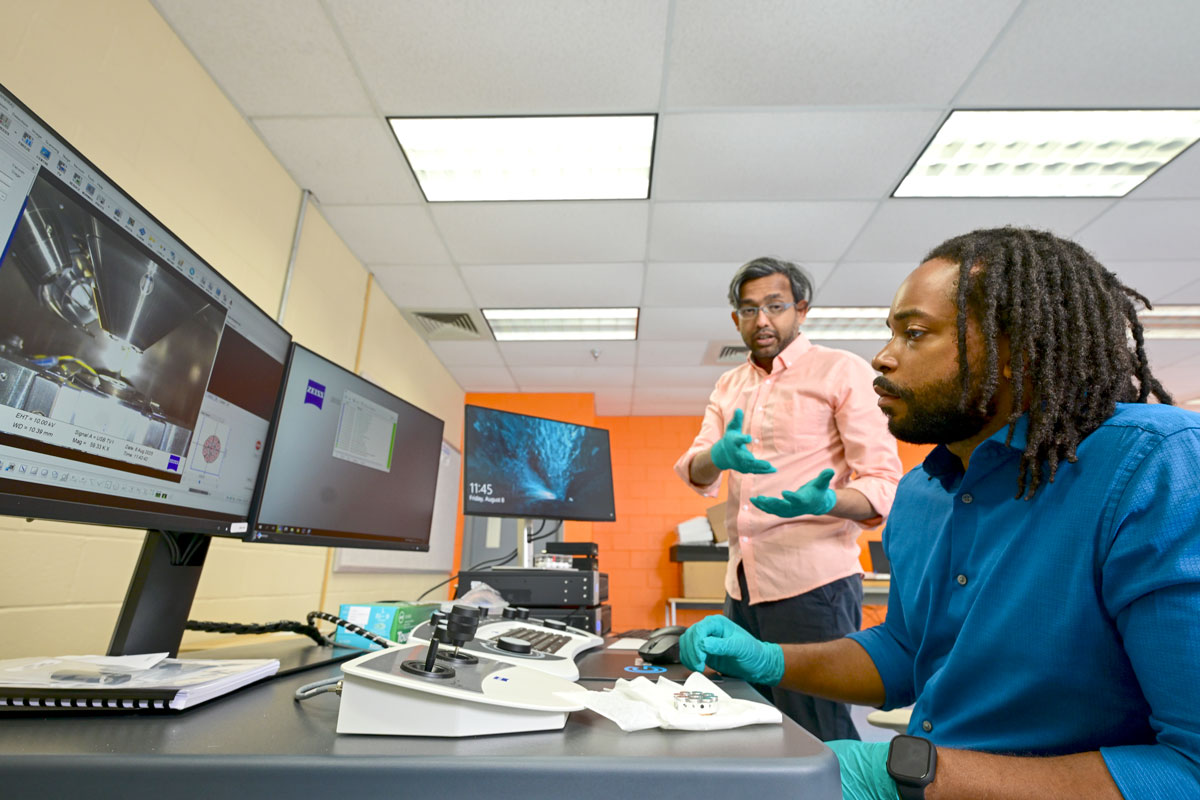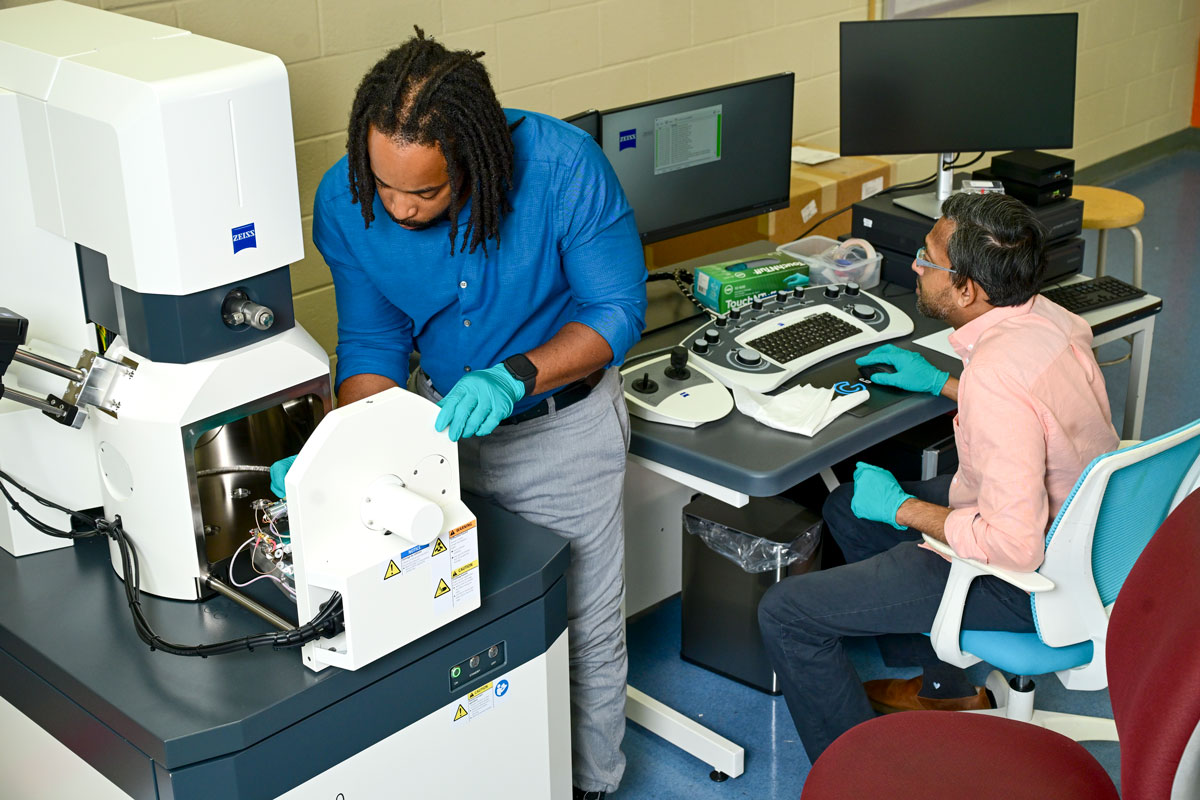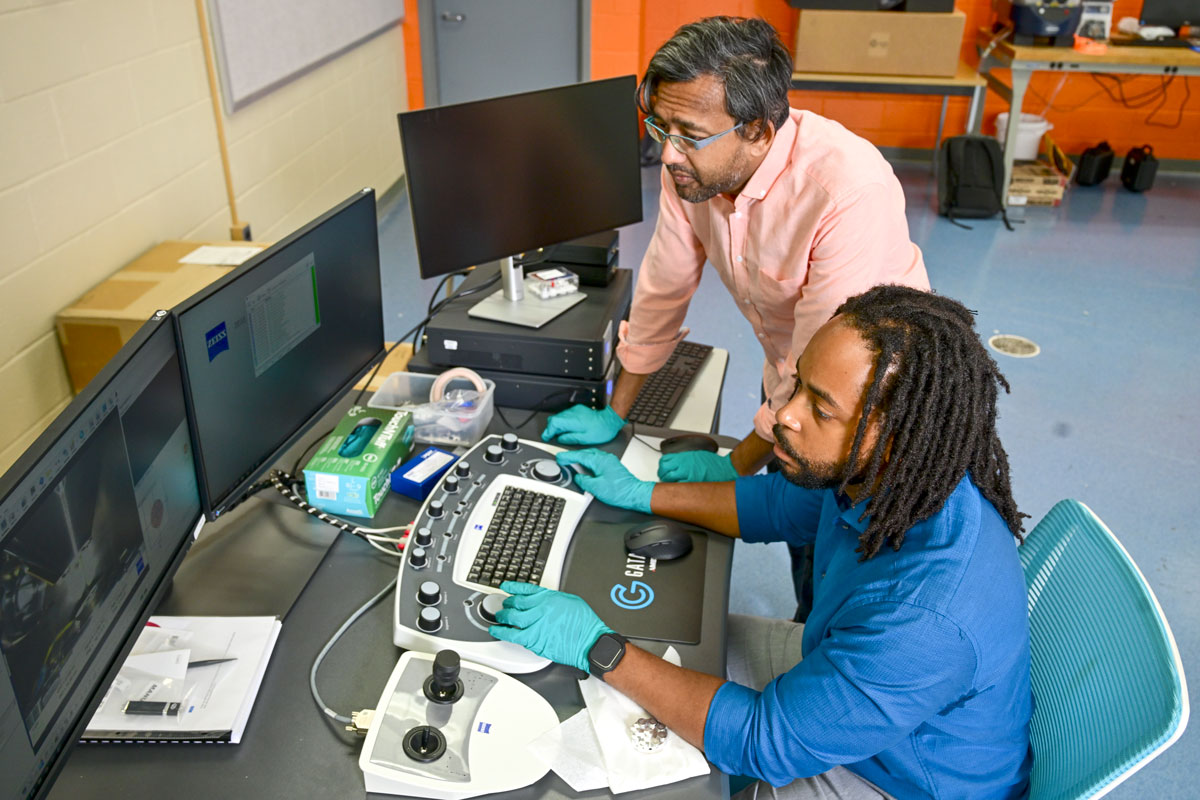By: T. Shawn Taylor
Realizing that I could manipulate and design these devices based on teeny tiny particles controlled by physics led me to microelectronics.
— Kristian Sellers,
Senior Electrical Engineering Major
It’s 6 a.m. Kristian Sellers is alone in the lab at Morgan State’s Center for Research and Education in Microelectronics. She comes early to set up her experiments then returns after 8 in the evening to resume taking measurements. In between, the returning, nontraditional student, a mother of two boys, aged 5 and 11, holds down a full load of classes. The flexibility is priceless, but so is the prospect of designing biomedical microelectronic devices aimed at eliminating health disparities in the African American community.
“Realizing that I could manipulate and design these devices based on teeny tiny particles controlled by physics led me to microelectronics,” says Sellers, a senior majoring in Electrical Engineering. “If you don’t have people in the room these issues would affect, a lot of the times, these issues get stuck under the rug and they are not factored into the design.”
Today’s “microelectronics revolution” has captured the fascination of individuals and industry alike. Prominent in the movement are students like Sellers and institutions like Morgan that are clamoring to the field, which involves the study, design and fabrication of the miniature circuits at the heart of many wondrous tools transforming industry and daily life. Personal computers, smartphones, industrial robots, MRI and CT scanners, smart home appliances, video games and advanced entertainment and safety features for autos are just a few of the countless products and processes made possible by the microchips and other components that make up the family of microelectronic devices.
Since opening in 2023, with the support of a $3.1-million annual allocation from the State of Maryland, the Center — located in the Mitchell Engineering Building of Morgan’s School of Engineering — has allowed Morgan students to examine numerous ways to apply microelectronics technology to improve lives, develop world-class products and solve complex problems.
Durojaiye pursued academics with discipline and rigor while also discovering a talent for sports photography and content creation. With a keen eye, and fueled by a relentless work ethic, he soon became a seminal figure transforming Morgan’s athletics coverage while earning national recognition.
From starting MSU Creatives, Morgan’s first-ever student-led content creator suite, to covering Major League Baseball’s HBCU Swingman Classic for Getty Images and participating in the Super Bowl LIX HBCU Experienceship, ’s story is a testament to the power of curiosity, initiative and the courage to step into the unknown.
“I came to Morgan with the only goal of going to the engineering building, studying and sticking to that path,” recalls. “But the beautiful thing about coming here is that there are so many opportunities just waiting to be tapped into.”
Once you create an excitement around a research topic like this and provide them with the equipment, the students find you.
— Dr. Michael Spencer,
Professor of Electrical and Computer Engineering

Foundation for Research
“As we enter the Information Age, microelectronics becomes the building block of everything,” says Michael Spencer, Ph.D., director of the Center and a professor in the Department of Electrical and Computer Engineering.
Now, with the construction of a 4,000-square-foot, state-of-the-art “clean room” set to begin in the fall, the Center is advancing the University’s strategic goal — strongly promoted by Morgan President David K. Wilson — of earning Carnegie’s esteemed R1 designation by 2030. R1 status applies to institutions that have achieved the highest level of research activity. To qualify for this top classification, higher education institutions must clear Carnegie’s threshold of $50 million in annual research and development spending and the award of 70 doctoral degrees per year. Morgan’s Microelectronics Center, and the University’s other vehicles for cutting-edge research, will move Morgan toward its R1 goal, by attracting more research grants and making the University a more competitive draw for doctoral students.
The clean room “will be a show piece, not just hidden behind some computer,” says M.V.S. Chandrashekhar, Ph.D., professor of Microelectronics in Morgan’s Department of Electrical and Computer Engineering. “It makes (the Center) physical and tangible.”
A clean room is a controlled environment designed to mitigate dust, hazardous gases, chemicals and microbes to protect the integrity of high-quality microelectronic components and semiconductors. Morgan’s clean room will have an estimated cost between $6 million and $8 million and will include a liquid nitrogen tank. The University has already secured $4 million of equipment.
Spencer explains that the clean room will also be the basis for facilitating interactions between Morgan and other research organizations. So far, the Center has led to what he describes as “wonderful interactions” between Morgan and Johns Hopkins University and the Army Research Laboratory. This advancement comes as the Center finalizes its partnership with the Smart USA Institute, a program of the Manufacturing USA network that focuses on advancing semiconductor manufacturing through digital twin technology.
The Center provides a foundation for microelectronics research at Morgan, as the United States, the original innovator of microelectronics, fights to regain ground lost to overseas competition in the 1990s.
“The whole ecosystem gradually shifted over time,” Spencer says. “Rather late in the day, we’re starting to reverse that trend. For many reasons — homeland security, defense, economic security — we’re trying to get it back. That’s the origin of the CHIPS Act.”
The CHIPS and Science Act, passed by Congress in 2022, provides $52.7 billion in funding to revitalize the domestic semiconductor industry to increase U.S. competitiveness in semiconductor research.
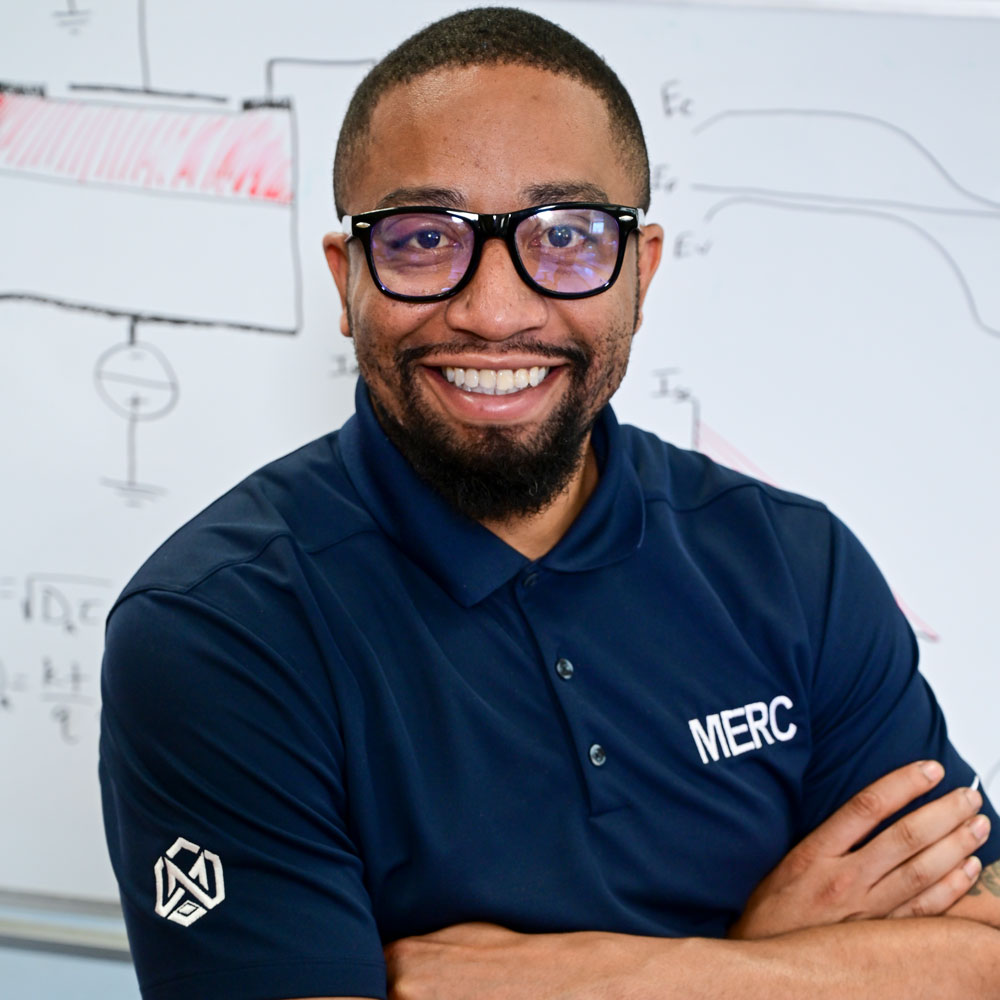
Bringing everyone together creates a powerful synergy that positions Morgan to make a strong impact in innovation and scientific discovery.
— Dr. Joshua Burrow,
Assistant Professor of Computer and Electrical Engineering
‘Powerful Synergy’
“As part of getting that back, we want to win the hearts and minds of young engineers,” Spencer says, adding that from the point of view of workforce participation by people of color in the industry, it’s critical that HBCUs like Morgan have a leadership role.
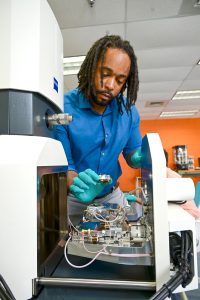 “So not only do you create a research impact and workforce development, but you take part in the legacy of scientists and engineers who make contributions to the field, and you make sure that legacy includes people of color,” he says.
“So not only do you create a research impact and workforce development, but you take part in the legacy of scientists and engineers who make contributions to the field, and you make sure that legacy includes people of color,” he says.
The State’s funding has enabled the Center to hire four new faculty members who lead a research cohort that includes two postdoctoral associates and 17 undergraduate and graduate students. Joshua Burrow, Ph.D., a Baltimore native and assistant professor in Morgan’s Department of Computer and Electrical Engineering, says the Center allows students to translate the theoretical concepts learned in the classroom into hands-on experience with state-of-the-art fabrication processes and characterization techniques.
“Morgan has a diverse campus, racially and ethnically and in terms of the background and expertise that lies within our faculty members in the Center,” Burrow says. “In order to do research in this field, we need people with different backgrounds, including engineering, physics, chemistry, material science and optics. Bringing everyone together creates a powerful synergy that positions Morgan to make a strong impact in innovation and scientific discovery.”
Baltimore native Monte Hendrix, an Air Force veteran and former helicopter mechanic who has spent a third of his career in the mental health field, says he wasn’t initially drawn to engineering. Now, he spends most of his time in the Center simulating devices to measure their performance and improve efficiencies.
“In 2023, I started thinking about the world at a molecular level, about particles and how they operate, and how we’ve been able to manipulate that knowledge to create the products around us,” says Hendrix, a senior majoring in Electrical Engineering with a concentration in Computer Engineering. “It teeters between physics and engineering. That’s what piques my interest the most.”
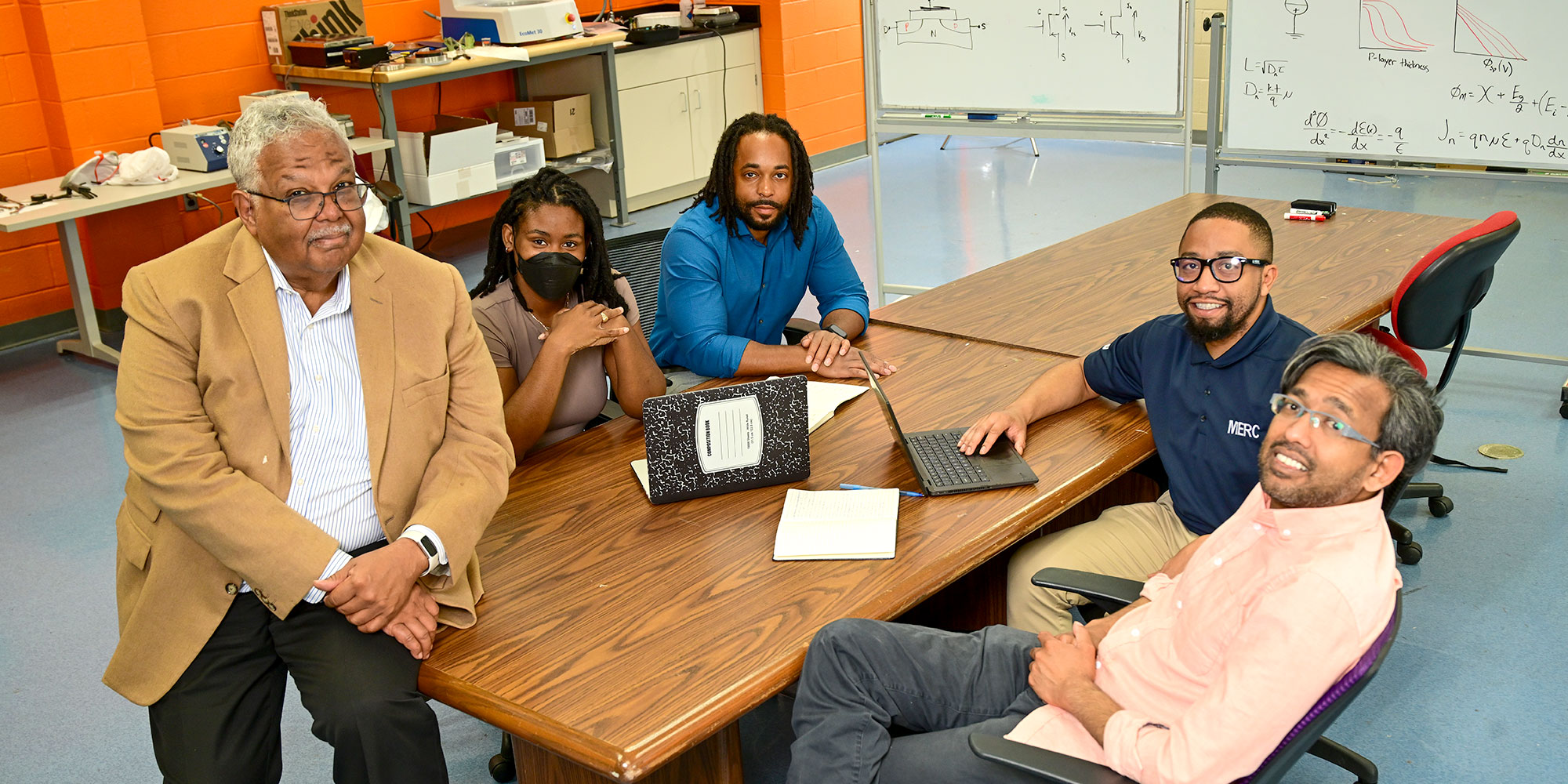
Broad Impact
When faculty members aren’t mentoring students, they are conducting a range of research experiments themselves, from building crystals, to making microchips for power electronics, to running clinical trials, to quantum computing and quantum sensing, which describes the utilization of quantum processes that are highly sensitive to their environment for sensitive measurement of physical parameters such as magnetic field intensity.
“For now, we’ve got our hands full,” Dr. Chandrashekhar says.
Because microelectronics is interdisciplinary, Morgan’s coursework draws heavily on the Chemistry program, the Ph.D. program in Electrical and Computer Engineering and the new doctoral physics program in Integrative Materials Science. Kishak Cinfwat, a doctoral candidate in Computer and Electrical Systems Engineering, from Nigeria, says his dissertation is primarily focused on modeling and simulation of nuclear batteries.
“Nuclear batteries have applications spanning health care, military and research. They tend to be very robust, and their operational life is roughly equal to the half-life of the nuclear material used. They are not affected by extreme temperatures like other batteries.” says Cinfwat, who plans to teach and continue researching after graduation.
Spencer stressed a Ph.D. isn’t needed to work in microelectronics. Morgan is working with Cornell University to develop certificate programs for community colleges that can be geared toward veterans who are leaving the service. He added Morgan is looking to create qualification programs and coursework so graduates can enter the workplace at the professional master’s level and at the bachelor’s level. Finding students won’t be difficult.
“Once you create an excitement around a research topic like this and provide them with the equipment, the students find you,” Spencer says. “That’s happening so fast and so much, it’s difficult to accommodate them all. I’m happy that Dr. Chandrashekhar and Dr. Burrow are here. It’s simply impossible for me to mentor the number of students who are interested.”


